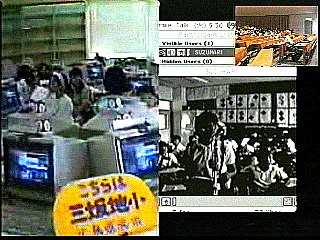Conference to introduce results from the 100-School Networking Project (Phase
II)
Elementary school meeting
Joint Study on Haiku, Using a Classroom Link between Elementary Schools
Motohiro Tamai, Suzuhari Elementary School
1. Introduction
- In elementary school, fixed attitudes and the tendency of children to put
classmates into pigeon-holes can lead to problems in the classroom. Children
sometimes find themselves unable to voice their opinions or new ideas in class.
As a solution and to motivate the students, teachers need to help them develop
a sense of right and wrong through educational activities, including regular
subjects, moral education, and special activities.
We conducted a joint study of haiku, Japanese poems consisting of seventeen
syllables, using a teleconferencing system. Mutual evaluations by students
have been traditional in most schools and classrooms, but in this class, children
from two distant schools evaluated each other via the Internet. This forced
students to reevaluate their ways of thinking, and made the lesson much more
interesting.
2. Prep work for the teleconferencing class
- (1) Suzuhari Elementary School
In May, 1996, children learned about haiku published in their textbook (Mitsumura
Tosho Publishing Co., Ltd).
Main content of study
- Read haiku from the textbook
- Write haiku themselves
- Present them in class
- Learn how to organize and record one's impressions of other student's haiku
- In June, each child wrote one haiku and presented it in class. They also
wrote their impressions of a poem that they liked written by another student.
By e-mail, they exchanged haiku with Misakaji Elementary School, and wrote
their impressions of a poem they liked, among those sent by students at Misakaji
Elementary School.
- (2) Misakaji Elementary School
As with Suzuhari Elementary School, children learned about haiku published
in their textbook (Mitsumura Tosho Publishing Co., Ltd).
Main content of study
- Read haiku from the textbook
- A more developed study using the Internet and books from the library
- Read tanka (poems with thirty-one syllables), haiku, senryu (poems with
seventeen syllables), not found in the textbook
- Study writing techniques and style, such as use of words describing the
seasons, and places to pause
- In June, every child wrote haiku, which they exchanged by e-mail with students
at Suzuhari Elementary School, and carried out activities similar to those
at Suzuhari Elementary School.
3. Outline of the teleconferencing lesson
- The haiku lessons done by teleconferencing began at 9 a.m. on June 10, 1997.
To create a more relaxed atmosphere, we began by introducing ourselves.
We followed the lesson format described below:
- (1) A child read his or her haiku aloud
(2) Children exchanged opinions about the poem
(3) The child who wrote the poem explained its meaning
- Figure 1. Pictures from the teleconferencing system


4. Children's impressions
- Children's impressions from the questionnaire, their diaries, and compositions
- (1) Positive opinions
- It was fun to talk to other kids while looking at them on a computer screen,
wondering what they're thinking and whether they're interested in what I'm
saying.
- It was interesting that my impressions about a particular haiku were sometimes
the same as the kid who wrote it, and sometimes a bit different.
- It was fun, because some kids' impressions about my haiku were different
from what I expected.
- I enjoyed hearing haiku written by students from a different school. I also
enjoyed explaining my own poem.
- It was fun to hear all the wonderful haiku. I liked studying with children
from a different school.
- I enjoyed listening to haiku written by students at a different school,
and I liked explaining my own poem. I was very happy that other kids listened
to my opinions. It was fun to see how the kids from the other school behaved,
and it was fun to explain our haiku to each other.
- It was a lot of fun. I hope we can do this again.
- (2) Negative opinions
- The picture was too small.
- I wish the picture was in color.
- The sound was bad.
- I couldn't give my presentation because time ran out.
- The display didn't show everyone in the class.
5. Conclusion
- Most educational activities at schools are carried out in a closed and controlled
atmosphere. This method of study is suited for some subjects, but for others,
it can be more effective to exchange ideas with people outside the school.
We prepared and conducted this lesson with the idea that linking classrooms
helps children reevaluate their own work and makes the lesson more interesting.
Most children had positive opinions about this trial, and many of the negative
opinions concerned problems with equipment. In the future, I hope computers
and the Internet will be more accessible to schoolchildren. I would like to
thank Mr. Masashi Ogawa, a teacher from Misakaji Elementary School, who ran
the lesson with me.
References
- [1] Motohiro Tamai and Shinichi Someoka (1997): "Study of the Educational
Use of the Internet—Trial of a Joint Study of Haiku by Linking Classrooms,"
from a collection of lectures given at *the fifth Educational Technology Association
National Convention*
[2] Shinichi Someoka, Motohiro Tamai, Sugiura, and Yamazaki
(1997): "A Study of the Educational Use of the Internet 6—Linking Classrooms
Using a Teleconferencing System," from a collection of lectures given
at *the fifth Educational Technology Association National Convention*
[3] Shozo Fukada, Motohiro Tamai, and Shinichi
Someoka: "The Day a Classroom is Connected to the Internet—Theory and
Practice in the Educational Use of the Internet" published by Kitaoji
Publishing Co., Ltd (now printing)
 Conference to introduce results from the 100-School Networking Project (Phase II)
Conference to introduce results from the 100-School Networking Project (Phase II)




 Conference to introduce results from the 100-School Networking Project (Phase II)
Conference to introduce results from the 100-School Networking Project (Phase II)